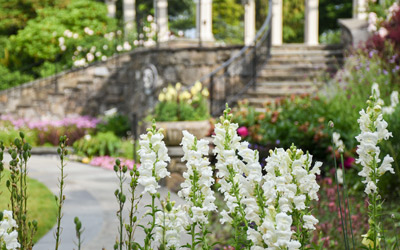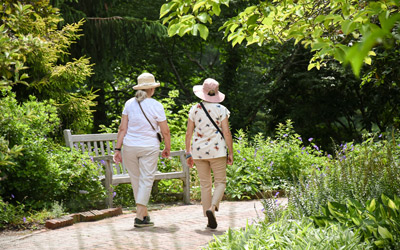EXPERIENCE SUMMER AT THE GARDEN
Every season brings its own sort of magic to the Garden experience, but there’s no doubt summer is a special time of year. From June through August, the Garden grows into a plant-lover’s paradise. Thousands of blooms, breathtaking exhibitions and events set in the gardens, and twilight experiences to enjoy with family and friends await. Summer at the Garden is the season to savor!
Things to do
Music in Bloom
Sundays, June 8 & 15, 6–8:45 PM
Join New England Botanic Garden and Juventas New Music Ensemble for a magical evening of music al fresco.
Thursday Summer Evenings
Thursdays, June 19–July, 5-9 p.m. & August, 5-8 p.m.
Escape to our garden oasis after hours! Enjoy live music from talented local musicians, sip refreshing craft beers and cocktails in our beer garden, play lawn games, and savor delicious dinner specials. Wander our woodland trails, admire the vibrant summer blooms, and enjoy colorful sunsets over the Wachusett Reservoir. Plus, discover an exciting lineup of workshops and classes for all ages—perfect for sparking creativity and connecting with nature. Thursday Summer Evenings are perfect for an after-work social, a fun night with friends, or a memorable evening with your family. Your new favorite tradition awaits!
Arias Aloft: Midsummer Magic
Sunday, July 13
Join us for a magical evening of opera and circus where soaring voices meet sky-high acrobatics in an unforgettable open-air spectacle.
Swing Night
Tuesday, August 5, 6-8:30 p.m.
Enjoy a high-energy dance concert of timeless big band swing featuring the 18-piece local talent, the Beantown Swing Orchestra.
LGBTQ+ Pride Celebration
September 4, 2025 | 5-9 p.m.
Join us as we celebrate our LGBTQ+ community and the week of Pride Worcester with an unforgettable evening of lively entertainment and fun festivities. Enjoy gardens of beautiful blooms and a beer garden serving craft drinks and light bites.
Garden Dining Series
Enjoy themed multicourse dining experiences in intimate settings at the Garden curated by Peppers Artful Events. Each dining experience focuses on a different cuisine, honoring plants, local agriculture, and the craft of cooking.
Plant Shows
New England Rose Society Show & Sale Saturday, June 21
New England Lily Society Show & Sale July 19 & 20
New England Daylily Society Show & Sale July 26
Art in Motion: 25 Years of Sculpture with George Sherwood
May 3 – October 12
Explore an extraordinary collection of kinetic sculptures, masterfully crafted by talented artist and engineer George Sherwood. Art in Motion spans an impressive 25 years of Sherwood’s artistic journey, showcasing 17 intricate stainless-steel sculptures that move in the wind.
Chinese Empresses by Xiang Li
June 14 – October 12
Experience the vibrant work of internationally acclaimed artist Xiang Li with a display depicting Chinese empresses throughout history. The works exhibited represent more than 200 empresses Li has painted on silk by hand with traditional Chinese watercolor.
Adults, families, and children will find an exciting lineup of nature-based learning opportunities at the Garden this season. From hands-on horticulture and gardening workshops to arts and wellness classes, nature ID, and more, there’s something for everyone. Explore the calendar.
A summer trip to the Garden wouldn’t be complete without a visit to the Garden Shop and café. Located in the Visitors Center, the Garden Shop features seasonal houseplants, gardening tools, books for all ages, jewelry, stationary, nature-inspired toys for children, and more. Meanwhile, the Farmer and the Fork café, open seven days a week for lunch, offers a variety of menu items prepared with fresh, locally-sourced ingredients. New this year – book an elegant picnic!
Science of the Season
When you feel like wilting in the summer heat, have you ever wondered how plants stay cool? Plants have the incredible ability to regulate their leaf temperature. During photosynthesis, plants absorb light energy through their leaves , but excess light energy can cause leaf temperature to rise. In order to cool its leaves, a plant will often close its stomata, or leaf pores. This conserves moisture, but because stomata are used for gas exchange, bringing carbon dioxide in and sending oxygen out, closing stomata can also disrupt the future photosynthesis ability of a plant. Fortunately, plants have evolved other creative ways to avoid overheating. Lamb’s ear (Stachys byzantina), for instance, has a lot of adaptations for heat tolerance. The plant’s silvery color helps reflect the sun’s rays and its hairy leaves shade the stomata and reduce contact from hot air. Other adaptations plants possess include transpiration—the process of releasing water through the stomata to cool the leaves, leaves that are oriented in a more vertical position, or hairs or a waxy coating on their leaves.
Thousands of people flock to the Garden in early spring to catch a glimpse of the Field of Daffodils—a stunning meadow that becomes a sea of gold and white as more than 25,000 daffodil bulbs bloom in April. But come May, the daffodils are gone, withered away and mowed over. In their place, common milkweed and other native plants sprout up. What was once the Field of Daffodils grows into a beautiful summer meadow and a pollinator’s paradise.
Meadows play an important part in the local ecosystem by functioning as early successional habitat. In recent decades, biologists have noted the decline of several species throughout the northeastern region as these habitats disappear due to increased development and repression of fire and other ground disturbances. In areas such as meadows, ground disturbances spur the growth of certain species that provide important resources to wildlife and contribute to the overall health of the ecosystem. At the Garden, we initiate these disturbances by mowing our meadows every few years and tracking the growth of certain plant species and wildlife that call them home. Look for Rudbeckia hirta or brown-eyed Susan throughout the Garden’s meadows. This short-lived perennial thrives in disturbed environments but is often outcompeted by larger perennials and grasses as meadows mature. This means that the plant’s ability to survive is dependent upon the initiated disturbances.
Drought, disease, and invasive species pose challenges that put pressure on plants. Due to climate change, summers have begun to get warmer and the risk of drought grows more common. With our changing climate, Massachusetts experiences the increased presence and shifting range of invasive species. Spongy moth (Lymantria dispar) populations, for example, used to be restricted by an to keep spongy moth populations limited. Without the necessary rain, the moth can continue to thrive with minimal barriers. Spotted lantern fly, English ivy, and Hemlock wooly adelgid are some other invasive species that have become more prominent in the region over the past few decades thanks in part to our changing climate (Entomophaga maimaiga) that thrived with early spring rains. Without the necessary rainfall, moth populations grow with minimal barriers putting pressure on trees and entire forest ecosystems. Spotted lantern fly, English ivy, and Hemlock wooly adelgid are some other invasive species that have become more prominent in the region over the past few decades thanks due in part to our changing climate.
Visit the Garden Blog for behind-the-scenes stories, horticultural how tos, and special news from the Garden. The Garden Blog is a resource for plant lovers of all kinds!
Summer Plant Spotlight
Wander formal gardens that feature enchanting summer designs and vibrant color palettes. Cool down in naturalistic spaces gathering inspiration in the Shade Garden or pack a picnic and see how many pollinators you can find on the plants of the Beneficial Border, located alongside the Lawn Garden.
As you explore the Garden this season, keep a look out for these summer favorites.

Peony (Paeonia spp. and cultivars)
These perennials are known for large showy flowers that bloom in late spring and early summer. Beautiful, but short-lived, peonies peony flowers persist only 7-10 days. The genus is comprised of more than 30 species. Different cultivars and species of peony have varying bloom times. At the Garden, these beautiful flowers typically show up toward the end of May through mid-June. You can find peonies throughout our garden spaces, including in the Lawn Garden, Secret Garden, Cottage Garden, Shade Garden, and Garden of Inspiration.
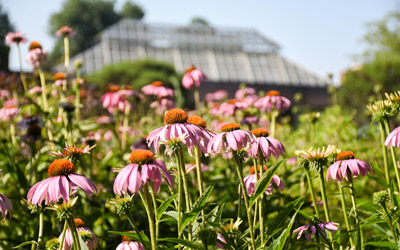
Coneflower (Echinacea spp. and cultivars)
The genus Echinacea has seven species all from eastern and central North America. Attractive to butterflies and other pollinators, coneflowers come in an array of different colors such as pink, red, purple, yellow, and white. These flowers often bloom anywhere from July to September and can be found throughout the Garden, including in the Lawn Garden, Secret Garden, Cottage Garden, and Garden of Inspiration.

False goat’s beard (Astilbe spp. and cultivars)
These herbaceous perennials are native to eastern North America and eastern Asia, although most astilbe used in gardens are hybrids of species from Japan and China. With more than 30 species, astilbe are often characterized by tiny, densely packed flowers packed into plume-like strands. These flowers are alluring to bees, butterflies, and other pollinators—a great addition to any garden looking for pollinator-friendly plants. You can find false goat’s beard in the Shade Garden, Wildlife Refuge Pond, Inner Park, Lawn Garden, and Cottage Garden.
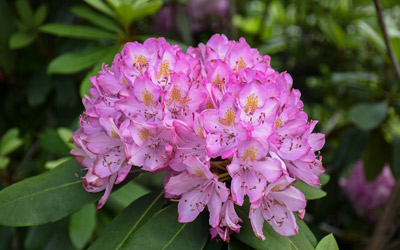
Rhododendrons and azaleas (Rhododendron spp. and cultivars)
There are 500-900 species in the genus Rhododendron that include what are commonly called rhododendrons and azaleas. True rhododendrons have 10 stamens in a flower, while azaleas only have five. Their showy flowers, with colors of white, pink, red, and purple, and attractive winter foliage make them a great plant for year-round interest. Rhododendrons and azaleas can be found throughout the grounds in the Shade Garden, Wildlife Refuge Pond, Inner Park, Lawn Garden, and Cottage Garden.

Iris (Iris spp. and cultivars)
Whether bold and showy or humble and modest, the intriguing flowers of the iris are always a sight to behold. Irises come in every color of the rainbow and boast vibrant details along their petals. The Garden is home to a number of different species including I. sibirica, I. ensata, and I. germanica, all of which bloom from late May through June. You can find irises in the Secret Garden, along the Secret Garden ramp, and in the Garden of Inspiration.
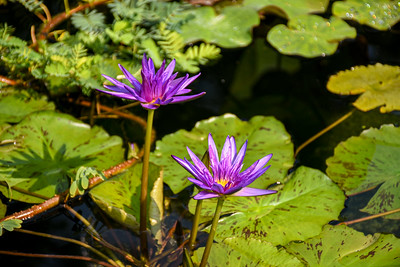
Water lily (Nymphaea spp. and cultivars)
Known and grown for their spectacular flowers, the Nymphaea genus features about 50 species of herbaceous aquatic perennials. The plants can be found worldwide and typically fall into one of two categories: winter-hardy or tropical. Winter-hardy water lilies tend to flower during the day, their flowers floating on the water, where tropical water lilies can flower day or night, their flowers extending above the water. The showy flowers can be pink, red, orange, yellow, purple, or white. These stunning aquatic plants can be found in the water features of The Ramble, Winter Garden, Secret Garden, and within the Wildlife Refuge Pond,




